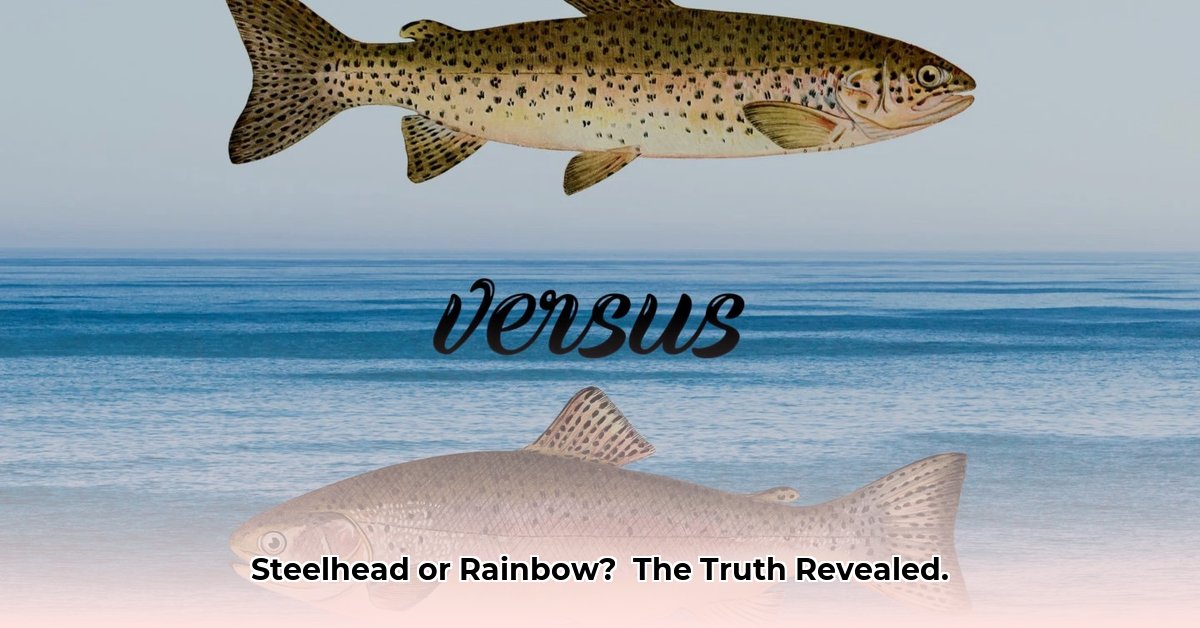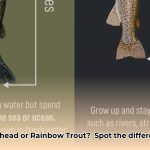Steelhead and rainbow trout are the same species, Oncorhynchus mykiss. This might seem surprising, given their often vastly different appearances. The key difference lies in their life history: steelhead are anadromous, meaning they migrate to the ocean and return to freshwater to spawn, while most rainbow trout remain in freshwater their entire lives. So, how can you tell them apart? This guide provides a comprehensive look at the visual cues and underlying biology that distinguish these two forms of the same remarkable fish.
Life Cycle: A Tale of Two Journeys
Two siblings, born into the same family, choose different paths. One stays home, content with the familiar. The other ventures into the unknown, facing challenges and hardship, returning transformed. This analogy captures the essence of the steelhead and rainbow trout story. Rainbows remain in their natal freshwater streams and lakes. Steelhead, however, embark on an epic migration to the ocean, braving predators and currents. Years later, they return to their birthplace as powerful, shimmering fish, ready to spawn.
Visualizing the Journey
(Visual aid here: An infographic comparing the rainbow trout’s freshwater life cycle with the steelhead’s ocean migration.)
Spotting the Difference: A Visual Guide
Let’s learn how to tell these fish apart in the field.
Size and Shape
Steelhead, sculpted by ocean currents, are typically longer and more torpedo-shaped than rainbow trout, which tend to be shorter and deeper-bodied. Think marathon runner versus powerlifter.
Coloration
Fresh from the ocean, steelhead glisten with a silvery sheen, camouflaging them in open water. Rainbows retain the vibrant, jeweled tones of their freshwater home, often displaying dazzling greens, yellows, and reds, punctuated by black spots.
The Kype and Battle Scars
Spawning male steelhead develop a hooked jaw called a kype, possibly used in competition for mates. Their arduous ocean journey can also leave them with scars and worn fins, setting them apart from their more pristine freshwater relatives.
(High-quality images comparing steelhead and rainbow trout side-by-side would be beneficial here.)
Key Characteristics: At a Glance
| Feature | Steelhead | Rainbow Trout |
|---|---|---|
| Size | Larger (20-30+ inches) | Smaller (10-20 inches) |
| Coloration | Silvery, often with faint spots | Vibrant, distinct spots |
| Jaw | Kype in spawning males | No kype |
| Fins | May show wear and tear | Generally pristine |
| Habitat | Ocean and freshwater | Freshwater |
Delving Deeper: Biology and Behavior
Why do some O. mykiss migrate while others don’t? Genetics certainly play a role, but environmental factors likely contribute as well. Water temperature, food availability, and competition might influence this migratory behavior. Research suggests that some individuals may be driven to the ocean by a scarcity of resources in their freshwater environment.
Decoding the “Lake-Run” Rainbow Trout
“Lake-run” rainbow trout, found in places like the Great Lakes, exhibit migratory behavior within freshwater systems. They move between lakes and rivers but never enter saltwater. Are they steelhead? It’s a topic of ongoing debate. Some classify them as a type of steelhead due to their migratory behavior, while others emphasize the saltwater aspect of the traditional steelhead definition.
The Farmed “Steelhead” Question
Farmed “steelhead” are rainbow trout raised in controlled environments, sometimes exposed to saltwater. While their diet and environment can influence their appearance, they haven’t faced the same selective pressures as wild steelhead. This lack of wild experience likely affects their overall resilience, behavior, and genetic diversity. So, while they may resemble steelhead, they are fundamentally different.
Conservation: Protecting O. mykiss
Both steelhead and rainbow trout face conservation challenges. Habitat loss and degradation, pollution, overfishing, and climate change all threaten these fish. Understanding their distinct life histories and habitat needs is crucial for effective conservation strategies. Protecting O. mykiss in all its forms requires a comprehensive approach that considers the interconnectedness of freshwater and marine ecosystems.
Further Exploration
Want to learn more? Here are some resources:
- Trout Unlimited – A conservation organization dedicated to protecting coldwater fisheries.
- Native Fish Society – An organization focused on the conservation of native fish species.
By appreciating the complexities of Oncorhynchus mykiss, we can better understand and protect these remarkable fish, ensuring that both the adventurer and the homebody continue to thrive.
- Hydro Extrusions USA Leads North American Aluminum Profile Solutions - December 28, 2025
- Hydro North America Leads Aluminum Extrusion Solutions Across Diverse Industries - December 27, 2025
- Hydro Extrusion North America Provides Custom Solutions Across Diverse - December 26, 2025
















